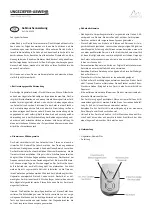
6.3.2 Recommendations for the replacement
of parts
- Replace diaphragm whenever necessary
Replacement intervals vary depending on the operating condi-
tions.
6.3.3 Inspection of the diaphragm
Whether the diaphragm is leak-free can be checked in installed
condition by turning out the plug on the inlet side when the ent-
ire equipment is depressurised.
Caution - danger! When the plug is opened while the equip-
ment is still under pressure, the plug may be blown out at high
speed.
After the plug has been opened, the valve is put under back-
pressure and it is checked whether water runs out of it.
Caution: In case the diaphragm is defective, large quantities of
the fluid conveyed will emerge - take appropriate safety pre-
cautions!
According to the recommended intervals, dismantle the valve
from the pipeline, open it and check the diaphragm for cracks.
If there are cracks, the diaphragm (spare part) must be repla-
ced. When assembling the diaphragm, make sure the dia-
phragm is placed properly into the seat and not distorted (to
make assembly easier, slightly grease the diaphragm with a sui-
table lubricant). Fasten the body screws evenly and crosswise
until the body halves have metal to metal contact.
6.3.4 Cleaning and lubrication
To ensure proper sealing, the diaphragm and the cone of the
seat must be cleaned from deposits contained in the medium.
It is not necessary to lubricate the diaphragm. Reassemble the
valve as described in Section 6.3.3.
7. Trouble-shooting
For all repair and maintenance work, please observe the
general safety instructions described in Section 6.1!
Problem
Cause
Remedial action
Diaphragm does not seal
Foreign particle jammed in the seat area
Purge valve, dismantle if necessary and
remove foreign particle.
Deposits from the medium on the seat or
diaphragm
Dismantle and open valve, clean the seat
area and the diaphragm.
Insufficient back-pressure
For complete sealing, the back-pressure
should be at least 3 m water column.
Defective diaphragm
Dismantle and open valve, replace
diaphragm (spare part).
Excessive wear and tear of diaphragm
Unfavourable installation position (e.g. too close
downstream of an elbow, or similar) which causes
unfavourable flow and fluttering of the diaphragm.
Change installation position (cf. Section 4).
Abrasive fluid (high content of solids)
Install a preliminary filter which retains the
particles.
Leaks at the body
Deteriorated seals or diaphragm
Replace seals or diaphragm (spare parts,
see Section 6).
8. How to contact us
Head office
VAG
GmbH
Carl-Reuther-Str. 1
68305 Mannheim
Germany
Telephone: +49 (621) 749-0
Fax: +49 (621) 749-2153
info@vag-
group
.com
http://www.vag-
group
.com
Service
Our service hotline can be reached 24/7 world-wide. In case of
emergency, please contact us by phone.
Service hotline: +49 (621) 749 2222
Service per email: service@vag-
group
.com



























